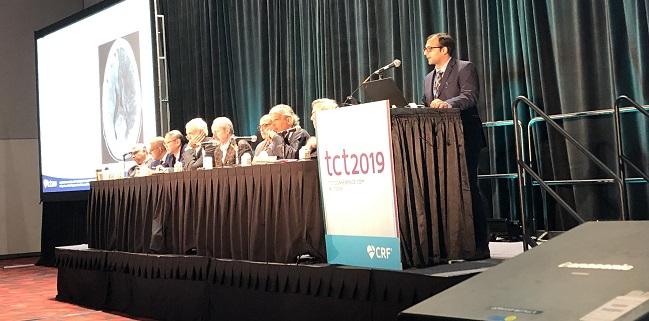Strokes Increasing in STEMI Patients With Cardiogenic Shock
Any stroke risks with mechanical circulatory support devices need to be balanced against potential benefits, one expert says.

SAN FRANCISCO, CA—The incidence of stroke in patients with STEMI and cardiogenic shock increased over a recent 10-year period in the United States, according to new retrospective data reported here at TCT 2019.
Between 2005 and 2014, the overall rate of stroke was 4.2%, but incidence rose for both ischemic and hemorrhagic events, Mohit Pahuja, MD (Wayne State University, Detroit, MI), said in his presentation.
Risk of stroke was highest among patients treated with extracorporeal membrane oxygenation (ECMO) versus other types of mechanical circulatory support (MCS) or no support at all. That heightened risk could be related to multiple factors, Pahuja said, including a heavier comorbidity burden, an increased systemic inflammatory response, and the risk of an imbalance in brain oxygenation called “North South Syndrome,” which can drive ischemic strokes.
When asked about the reasons for the rising stroke rate in the setting of STEMI and cardiogenic shock, Pahuja said more research is needed, but noted that increasing clinical awareness of the need to look for stroke, changes in comorbidities, and greater use of percutaneous support devices could all be contributing.
Figuring out “what we can do to prevent this [trend], I think this will be the next step,” he said.
Mortality, Length of Stay, and Costs
Adverse neurological outcomes like stroke and intracranial bleeding are key complications in patients with STEMI, and cardiogenic shock further boosts stroke risk related to decreased blood flow to the brain and an elevated inflammatory response. STEMI patients also often have multiple comorbidities that are themselves tied to greater stroke risk and require antiplatelet and anticoagulant therapies that in turn boost intracranial bleeding risk, Pahuja noted.
In recent years, use of percutaneous MCS devices has become more popular for patients with cardiogenic shock, and these devices carry a stroke risk of their own. There are limited data, however, on stroke risk in patients with STEMI and cardiogenic shock, Pahuja said.
In this study, Pahuja and his colleagues, including senior investigator Navin Kapur, MD (Tufts Medical Center, Boston, MA), examined data from the National Inpatient Sample on 172,491 patients admitted to US hospitals with a primary diagnosis of STEMI and cardiogenic shock between 2005 and 2014.
Overall, patients who had a stroke were more likely to die in the hospital (38.5% vs 29.8%; adjusted OR 1.37; 95% CI 1.22-1.54). That finding was consistent in patients who did not receive any MCS device and in those who received an intra-aortic balloon pump (IABP). Stroke was not associated with a significantly greater risk of in-hospital mortality in the subgroups of patients who received either an Impella (Abiomed) or TandemHeart (LivaNova) percutaneous ventricular assist device (pVAD) or who underwent ECMO, although there was a numerical difference in the pVAD group.
In the ECMO group, mortality was 55.9% regardless of whether patients had a stroke. “Mortality is highest among ECMO patients with or without stroke, suggesting that these are critically ill patients,” Kapur said in an email.
Stroke was also tied to a longer hospital stay (18 vs 11 days) and a higher total hospitalization cost ($215,692 vs $142,213; P < 0.0001 for both), findings that tended to be consistent across treatment subgroups. “We need to come up with better strategies to decrease the economic burden of this disease if it happens,” Pahuja said.
And, he said, considering the high cost and poor outcomes associated with stroke in this setting, further studies are needed to determine what’s causing strokes and whether neuroprotective strategies may play a role in mitigating the risk in patients who require MCS devices.
‘Don’t Throw the Baby Out With the Bath Water’
American College of Cardiology spokesperson B. Hadley Wilson, MD (Sanger Heart & Vascular Institute, Charlotte, NC), noted to TCTMD that use of MCS has grown in the setting of cardiogenic shock and—though data remain sparse—there have been some hints that certain devices may improve survival.
The rising stroke rate observed in this study may be related to greater use of MCS, but that requires further study, Wilson commented. “I think we’re going to find over time that this may indeed save more lives and then, at that point, we’ll have to balance the risk of stroke versus the benefit of saving more lives with these mechanical support devices.”
Wilson said the risk of stroke shouldn’t discourage further research into various MCS technologies in patients with cardiogenic shock. But, he added, “it begets the question about whether or not there should be some type of protection for the cerebral vasculature that should be employed in these patients, similar to TAVR.”
For now, physicians should be aware of and try to minimize the potential stroke risk associated with MCS devices in STEMI patients with cardiogenic shock, “but we shouldn’t throw the baby out with the bath water until we know fully their benefit in this high-risk group,” Wilson said.
Todd Neale is the Associate News Editor for TCTMD and a Senior Medical Journalist. He got his start in journalism at …
Read Full BioSources
Pahuja M. Incidence and clinical outcomes of stroke in patients with STEMI and cardiogenic shock: insights from large national database. Presented at: TCT 2019. September 25, 2019. San Francisco, CA.
Disclosures
- Pahuja and Wilson report no relevant conflicts of interest.


Comments